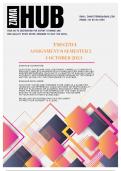, 1.1.1.Poor Teaching.
Poor teaching can have a significant negative impact on learners' learning. For example, teachers
who are not well-versed in their subject matter may struggle to communicate concepts effectively
or may present inaccurate information. This can lead to learners developing a poor understanding
of the subject matter. Moreover, teachers who lack effective planning and presentation skills may
create lessons that are disorganized, confusing, and unengaging. Learners may disengage from the
learning process, leading to poor academic performance.
[Alternative Answer]
Poor teaching refers to ineffective instructional methods, lack of preparation, or insufficient
engagement with learners, which can severely hinder students' learning. When teachers fail to plan
lessons appropriately, use unengaging methods, or lack the necessary subject knowledge, students
may not grasp key concepts or develop critical thinking skills.
Impact on Learners: Poor teaching often results in students disengaging from the learning
process, leading to poor academic performance and a lack of interest in the subject. Learners
may feel frustrated, especially if their individual needs are not recognized or addressed by the
teacher. This can ultimately lead to learners falling behind their peers.
Practical Example: In a Business Studies class, if a teacher only lectures without using
interactive strategies such as group work, real-life business case studies, or multimedia,
students may find it difficult to apply theoretical concepts to practical situations. As a result,
learners may struggle to understand business concepts, which may affect their ability to
perform well in exams or practical tasks.
1.1.2.Overcrowded Classrooms.
Overcrowded classrooms present a significant barrier to learning, negatively affecting both
teachers and learners. This problem is particularly acute in South Africa. Large class sizes make it
challenging for teachers to provide individual attention to learners, hindering their ability to cater
to diverse learning needs. This can be particularly detrimental to learners who require additional
support or who struggle with certain concepts. Additionally, overcrowded classrooms can create a
chaotic and disruptive learning environment, making it difficult for learners to concentrate and for
teachers to manage behavior effectively.
[Alternative Answer]
Overcrowded classrooms are those with more students than the recommended or ideal number,
which can significantly disrupt the learning environment. When there are too many students in a
classroom, the teacher may struggle to manage the class, provide individual attention, or ensure
that all students are actively engaged.
Impact on Learners: In overcrowded classrooms, learners often receive less one-on-one
support from the teacher. It becomes challenging to maintain discipline, and learners who need




